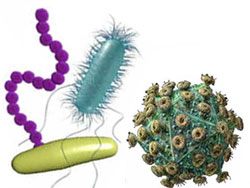Causes of Infective Endocarditis

Infective endocarditis occurs when bacteria, fungi and, on rare occasions, viruses or protozoa enter the endocardium. Very frequently infective endocarditis is a complication of sepsis (a systemic inflammatory response to severe infection). The bacteria mostly adhere to valves and less frequently to parietal endocardium and artificial valves.
Infective endocarditis can be caused by the following microorganisms:
- Streptococcus viridans – this microorganism is responsible for 50-60% of the cases of subacute infective endocarditis (other sources claim that the numbers are as high as 80%).
- Staphylococcus aureus – this microorganism is the most common cause of acute infective endocarditis, intravenous drug abusers' infective endocarditis, healthcare-associated infective endocarditis, and prosthetic valve endocarditis. About 35-60.5% of the patients who had staphylococcal septicemia also develop infective endocarditis. The mortality rate of patients with infective endocarditis caused by S. Aureus is 40-50%.
- Streptococcus intermedius group – can cause both acute and subacute infective endocarditis and it is responsible for 15% of the cases of infective endocarditis. These microorganisms are unique among other streptococci, as they have a tendency to invade tissues and cause abscesses.
- Fungal infection – usually causes subacute form of infective endocarditis. The most common member of this group is Candida albicans. Most commonly this infection appears in patients who went through a prolonged therapy using broad-spectrum antibiotics.
- Other microorganisms - includes streptococcus intermedius group, abiotrophia, group A, B, C, and D streptococci, nonenterococcal group D, Coagulase-negative S aureus, Pseudomonas aeruginosa, HACEK, Bartonella and polymicrobial infection.
Risk Factors
The following risk factors greatly increase the risk of infective endocarditis:
- Residual damage to valves caused by the previous attack of endocarditis - the most significant risk factor as it is easier for infection to adhere and multiply on damaged heart valves. Moreover, congenital heart defects also make the person more susceptible to infection. Rheumatic fever can also cause damage to the heart’s valves later resulting in infective myocarditis.
- Artificial valves - prosthetic valves, like damaged valves, have the tendency to accumulate bacteria, resulting in infective endocarditis. This condition even has its own name – prosthetic valve endocarditis (PVE). PVE usually occurs shortly after surgery. Infection of the replaced aortic valve often leads to fistula formation, local abscess and valvular dehiscence. This may result in shock, heart block, heart failure, shunting of blood into the right atrium, peripheral emboli, and pericardial tamponade (when the blood spills into pericardial cavity which makes it impossible for the heart to function).
- Intravenous drug abuse - People who use intravenous drugs are much more susceptible to infective myocarditis caused by S. aureus (about 50% of the cases). Enterococci and groups A, C, and G streptococci are also often responsible for the infection.
- Installation of intravascular devices - Installation of defibrillators and pacemakers, catheters and hemodialysis shunt, hyperalimentation and chemotherapeutic lines and central or peripheral intravenous catheters can result in infective endocarditis. Usually these patients also have a number of comorbidities (additional disorders) and are in a more advanced age group, which makes the prognosis less favorable. Additionally, maintenance of these devices can be even more risky than their implantation. For example, the risk of infection when changing the battery on a pacemaker is 5 times greater than during the initial implantation (6.5% and 1.4% respectively).
Next Chapter: Symptoms of Endocarditis
Featured Articles
A stroke can cause problems with communication if there is damage to the parts of the brain responsi ...
People with irregular bowel movements often complain about elevated blood pressure that doesn’ ...
A mini-stroke is a temporary disruption in blood flow to the brain, spinal cord or retina that doesn ...
It is well known that rheumatoid arthritis is an auto-immune disease that primarily affects joints. ...









